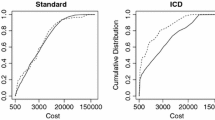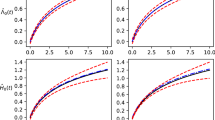Abstract
Recurrent event data are often collected in longitudinal follow-up studies. In this article, we propose a semiparametric method to model the recurrent and terminal events jointly. We present an additive–multiplicative hazards model for the terminal event and a proportional intensity model for the recurrent events, and a shared frailty is used to model the dependence between the recurrent and terminal events. We adopt estimating equation approaches for inference, and the asymptotic properties of the resulting estimators are established. The finite sample behavior of the proposed estimators is evaluated through simulation studies. An application to a medical cost study of chronic heart failure patients from the University of Virginia Health System is illustrated.
Similar content being viewed by others
References
Andersen PK, Gill RD (1982) Cox’s regression model for counting processes: a large sample study. Ann Stat 10:1100–1120
Byar DP (1980) The Veterans administration study of chemoprophylaxis for recurrent stage I bladder tumors: comparisons of placebo, pyridoxine and topical thiotepa. In: Pavone-Macaluso M, Smith PH, Edsmyr F (eds) Bladder tumors and other topics in urological oncology. Plenum, New York, pp 363–370
Claeskens G, Hjort NL (2008) Model selection and model averaging. Cambridge University Press, Cambridge
Cook RJ, Lawless JF (1997) Marginal analysis of recurrent events and a terminating event. Stat Med 16:911–924
Cook RJ, Lawless JF, Lakhal-Chaieb L, Lee KA (2009) Robust estimation of mean functions and treatment effects for recurrent events under event-dependent censoring and termination: application to skeletal complications in cancer metastatic to bone. J Am Stat Assoc 104:60–75
Ghosh D, Lin DY (2000) Nonparametric analysis of recurrent events and death. Biometrics 56:554–562
Ghosh D, Lin DY (2002) Marginal regression models for recurrent and terminal events. Stat Sin 12:663–688
Ghosh D, Lin DY (2003) Semiparametric analysis of recurrent events data in the presence of dependent censoring. Biometrics 59:877–885
Han M, Song X, Sun L, Liu L (2016) An additive-multiplicative mean model for marker data contingent on recurrent event with an informative terminal event. Stat Sin 26:1197–1218
Huang CY, Wang MC (2004) Joint modeling and estimation of recurrent event processes and failure time. J Am Stat Assoc 99:1153–1165
Kalbfleisch JD, Schaubel DE, Ye Y, Gong Q (2013) An estimating function approach to the analysis of recurrent and terminal events. Biometrics 69:366–374
Liang KY, Zeger SL (1986) Longitudinal data analysis using generalized linear models. Biometrika 73:13–22
Lin DY, Wei LJ, Yang I, Ying Z (2000) Semiparametric regression for the mean and rate function of recurrent events. J R Stat Soc B 69:711–730
Lin DY, Ying Z (1995) Semiparametric analysis of general additive–multiplicative hazard models for counting processes. Ann Stat 23:1712–1734
Lin DY, Ying Z (2001) Semiparametric and nonparametric regression analysis of longitudinal data. J Am Stat Assoc 96:103–126
Liu L, Huang X, O’Quigley J (2008) Analysis of longitudinal data in the presence of informative observational times and a dependent terminal event, with application to medical cost data. Biometrics 64:950–958
Liu L, Wolfe RA, Huang X (2004) Shared frailty models for recurrent events and a terminal event. Biometrics 60:747–756
Liu Y, Wu Y, Cai J, Zhou H (2010) Additive-multiplicative rates model for recurrent events. Lifetime Data Anal 16:353–373
Martinussen T, Scheike TH (2002) A flexible additive multiplicative hazard model. Biometrika 89:283–298
Miloslavsky M, Keles S, Van der Laan MJ, Butler S (2004) Recurrent events analysis in the presence of time-dependent covariates and dependent censoring. J R Stat Soc B 66:239–257
Pan Q, Schaubel DE (2009) Flexible estimation of differences in treatment-specific recurrent event means in the presence of a terminating event. Biometrics 65:753–761
Rondeau V, Mathoulin-Pelissier S, Jacqmin-Gadda H, Brouste V, Soubeyran P (2007) Joint frailty models for recurring events and death using maximum penalized likelihood estimation: application on cancer events. Biostatistics 8:708–721
Rondeau V, Mazroui Y, Gonzalez JR (2012) frailtypack: an R package for the analysis of correlated survival data with frailty models using penalized likelihood estimation or parametrical estimation. J Stat Softw 47:1–28
Schaubel DE, Zeng D, Cai J (2006) A semiparametric additive rates model for recurrent event data. Lifetime Data Anal 12:389–406
Schaubel DE, Zhang M (2010) Estimating treatment effects on the marginal recurrent event mean in the presence of a terminating event. Lifetime Data Anal 16:451–477
Scheike TH, Zhang MJ (2002) An additive-multiplicative Cox–Aalen regression model. Scand J Stat 29:75–88
Sun L, Kang F (2013) An additive-multiplicative rates model for recurrent event data with informative terminal event. Lifetime Data Anal 19:117–137
Sun L, Song X, Zhou J, Liu L (2012) Joint analysis of longitudinal data with informative observation times and a dependent terminal event. J Am Stat Assoc 107:688–700
van der Vaart AW, Wellner JA (1996) Weak convergence and empirical processes. Springer, New York
Volinsky CT, Raftery AE (2000) Bayesian information criterion for censored survival models. Biometrics 56:256–262
Wang MC, Qin J, Chiang CT (2001) Analyzing recurrent event data with informative censoring. J Am Stat Assoc 96:1057–1065
Ye Y, Kalbfleisch JD, Schaubel DE (2007) Semiparametric analysis of correlated recurrent and terminal events. Biometrics 63:78–87
Zeng D, Cai J (2010) Semiparametric additive rate model for recurrent events with informative terminal event. Biometrika 97:699–712
Zeng D, Lin DY (2006) Efficient estimation of semiparametric transformation models for counting processes. Biometrika 93:627–640
Zeng D, Lin DY (2009) Semiparametric transformation models with random effects for joint analysis of recurrent and terminal events. Biometrics 65:746–752
Zhao X, Zhou J, Sun L (2011) Semiparametric transformation models with time-varying coefficients for recurrent and terminal events. Biometrics 67:404–414
Acknowledgements
The authors would like to thank the reviewers for their constructive and insightful comments and suggestions that greatly improved the paper. This research was partly supported by the National Natural Science Foundation of China (Grant Nos. 11601307, 11771431 and 11690015) and Key Laboratory of RCSDS, CAS (No. 2008DP173182).
Author information
Authors and Affiliations
Corresponding author
Ethics declarations
Conflict of interest
On behalf of all authors, the corresponding author states that there is no conflict of interest.
Appendices
Appendix A: Proofs of asymptotic results
In this section, we will use the same notation defined above and all limits are taken at \(n \rightarrow \infty \). Let \(\bar{q}(t)\) be the limit of \(\bar{Q}(t;\beta _0,\eta _0)\). In order to study the asymptotic distributions of \(\hat{\beta }, \hat{\eta }\) and \(\hat{\gamma },\) we need the following regularity conditions:
-
(C1)
\(P(Y \ge \tau , v>0)>0,\) \(\Lambda _0(\tau )>0\) and \(E\{N(\tau )^2\} <\infty .\)
-
(C2)
\(G(t)=E\{v I(Y \ge t) \exp (\gamma _{0}'X)\}\) is a continuous function for \(t \in [0, \tau ].\)
-
(C3)
A is nonsingular, where
Define \(R(t)=G(t)\Lambda _0(t)\), \(H(t)=\int _0^t G(u)d\Lambda _0(u),\) \(D_1=E\{\exp \{ \alpha _0' X_{i}^*\} X_{i}^{* \otimes 2}\}, \)
and
where \(P_1(x^*,y,m)\) is the joint probability measure of \((X_{i}^*, Y_i, m_i).\) Let \(\phi _{1i}\) denote the vector \(D_1^{-1}e_i\) without the first entry and \(\phi _{2i}\) denote the first entry of \(D_1^{-1}e_i\). Set \(\varphi _i(t)=\kappa _i(t)+\phi _{2i}\), and \(b_i(y,x)=\varphi _i(y)+\phi _{1i}' x\).
Proof of Theorem 1
Under conditions (C1) and (C2), it follows from Wang et al. (2001) that
holds uniformly in t, and
By using the Taylor expansion theorem, (A.1) and (A.2), we have
where \(o_p(.)\) is independent of i since (A.1) holds uniformly in t.
Define
Then \(M^D_i(t)\) is a zero-mean process. Hence using the functional version of the law of large numbers and Lemma A.1 of Lin and Ying (2001), we get
Combing (A.3) and (A.4), we obtain
where
and \(P_2(q,z,w,x,y,m)\) is the joint probability measure of \((Q_i(\beta _0,\eta _0), Z_i,W_i,X_i,Y_i,m_i)\).
Thus, by (A.5) and the multivariate central limit theorem, \(n^{-1/2}U(\beta _0,\eta _0)\) converges in distribution to a zero-mean normal random vector with covariance matrix \(\Sigma =E(\xi _i\xi _i')\). Note that \(-n^{-1}\partial {U}(\beta _0, \eta _0)/\partial (\beta ',\eta ')\) converges in probability to A, which is defined in condition (C3). By Taylor expansion theorem, we have that
which converges in distribution to a joint normal distribution with mean zero and covariance matrix \(A^{-1}\Sigma A'^{-1}.\) \(\square \)
Proof of Theorem 2
Note that
and define
\(\hat{\mathcal A}_0(t;\beta ,\eta )\) is a continuous functional of two processes because the denominator is bounded away from 0. The almost-sure convergence of the two processes can be established from the previous discussions. It can be shown that \(\sup _{t\in [0,\tau ]}|\hat{\mathcal {A}}_0(t;\beta ,\eta )-{\mathcal {A}}_0(t;\beta ,\eta )|\rightarrow 0\) almost surely. Then the consistency of \(\hat{\mathcal {A}}_0(t;\hat{\beta },\hat{\eta })\) for \({\mathcal {A}}_0(t)\) follows the strong consistency of \(\hat{\beta }\) and \(\hat{\eta }\) for \(\beta _0\) and \(\eta _0\).
A Taylor expansion of \(\hat{\mathcal {A}}_0(t;\hat{\beta },\hat{\eta })\) about \(\beta _0\) and \(\eta _0\) gives
where \(\beta _t^*\) depends on t and lies on the line segment between \(\hat{\beta }\) and \(\beta _0\), \(\eta _t^*\) depends on t and lies on the line segment between \(\hat{\eta }\) and \(\eta _0\). By a similar argument used earlier, we can show that \({\partial \hat{\mathcal {A}}_0(t;\beta _t^*,\eta _t^*)}/{\partial \beta }\) converges in probability to \({\partial {\mathcal {A}}_0(t;\beta _0,\eta _0)}/{\partial \beta }\), and \({\partial \hat{\mathcal {A}}_0(t;\beta _t^*,\eta _t^*)}/{\partial \eta }\) converges in probability to \({\partial {\mathcal {A}}_0(t;\beta _0,\eta _0)}/{\partial \eta }\) for \(t\in [0,\tau ]\). Following Theorem 1,
and from (A.6), we have
Moreover, the functional delta method applied to \(\hat{\mathcal {A}}_0(t;\beta _0,\eta _0)\) yields
From (A.3), it is easy to show that
where
and \(P_3(z,x,y,m)\) is the joint probability measure of \((Z_i,X_i,Y_i,m_i)\). In a similar manner, from (A.3), it is easy to show that
where
and \(P_{4}(w,x,y,m)\) is the joint probability measure of \((W_i,X_i,Y_i,m_i)\).
Thus, it follows from (A.8), (A.9) and (A.10) that
By definition, \(\hat{\mathcal {A}}_0(t;\hat{\beta },\hat{\eta })=\hat{\mathcal {A}}_0(t)\) and \({\mathcal {A}}_0(t;\beta _0,\eta _0)={\mathcal {A}}_0(t)\), it follows from (A.7) and (A.11) that
where
Because \(\Psi _i(t)\) is a linear combination of monotone processes with bounded second moments, the weak convergence of \(n^{1/2}\{\hat{\mathcal {A}}_0(t)-{\mathcal {A}}_0(t)\}\) follows form example 2.11.16 of Vaart and Wellner (1996). \(\square \)
Appendix B: The choice of the weight function \(Q_i(\beta ,\eta )\)
If the baseline hazard function \(\alpha _0(\cdot )\) is known, then the likelihood for \((\beta _0,\eta _0)\) is proportional to
The corresponding score function is
and
In order to develop estimation procedures for \((\beta _0,\eta _0)\) when \(\alpha _0(\cdot )\) is completely unspecified, (B.1) and (B.2) should be modified to eliminate \(\alpha _0(\cdot )\) from the estimating functions. Thus, we replace the integrands in (B.1) and (B.2) by \(Q_i(\beta ,\eta )\), which is a smooth \((p+q)\)-vector-value function of \((Z_i, W_i, \beta , \eta ),\) and replace \(\alpha _0(t) dt \) in \(M_i^D(t;\beta ,\eta )\) by \(\tilde{\mathcal A}_0(t;\beta ,\eta )\), which is the Aalen–Breslow type estimator for \({\mathcal A}_0(t)=\int _0^t\alpha _0(s)ds\) with known \(v_i\) and \((\beta ,\eta )\), that is,
Then we obtain the following estimating equation for \((\beta _0,\eta _0)\):
where
It can be checked that the estimating equation (B.3) is equivalent to the estimating equations on pages 5 and 6. Obviously, \(Q_i(\beta ,\eta )\) in (7) will be a good approximation to the integrands in (B.1) and (B.2) if \(\alpha _0(\cdot )\) is roughly constant and \(g(\cdot )\) is small relative to \(\alpha _0(\cdot )h(\cdot )\). In addition, putting (7) into (6), we obtain
where
with
and
If \((Z_i',W_i')'=Z_i\), then \(U_{\beta }\) becomes the estimating function of Huang and Wang (2004) under the multiplicative hazards model with a frailty:
If \((Z_i',W_i')'=W_i\), then \(U_{\eta }\) reduces to an ad hoc estimating function for additive hazards model with a frailty:
Rights and permissions
About this article
Cite this article
Han, M., Sun, L., Liu, Y. et al. Joint analysis of recurrent event data with additive–multiplicative hazards model for the terminal event time. Metrika 81, 523–547 (2018). https://doi.org/10.1007/s00184-018-0654-3
Received:
Published:
Issue Date:
DOI: https://doi.org/10.1007/s00184-018-0654-3




